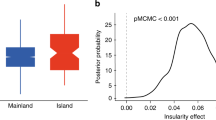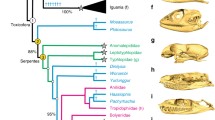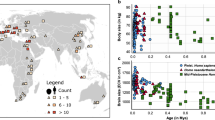Abstract
One of the major adaptations during the evolution of Homo sapiens was an increase in brain size. Here we present evidence that a significant and substantial proportion of variation in brain size may be related to changes in temperature. Based on a sample of 109 fossilized hominid skulls, we found that cranial capacities were highly correlated with paleoclimatic changes in temperature, as indexed by oxygen isotope data and sea-surface temperature. Indeed, as much as 52% of the variance in the cranial capacity of these skulls could be accounted for by temperature variation at 100 ka intervals. As an index of more short-term seasonal fluctuations in temperature, we examined the latitude of the sites from which the crania originated. More than 22% of the variance in cranial capacity of these skulls could be accounted for by variation in equatorial distance.




Similar content being viewed by others
References
Ash, J. A., & Gallup, G. G. Jr. (2007). Brain size, intelligence, and paleoclimatic variation. In G. Gehr & G. Miller (Eds.), Mating intelligence: Sex, relationships, and the mind’s reproductive system. Mahwah, NJ: Lawerence Erlbaum Associates.
Aiello, L. C., & Wood, B. A. (1994). Cranial variables as predictors of hominine body mass. American Journal of Physical Anthropology, 95, 409–426.
Andreasen, N. C., Flaum, M., Swayze II, V., O’Leary, D. S., Alliger, R., Cohen, G., et al. (1993). Intelligence and brain structure in normal individuals. American Journal of Psychiatry, 150, 130–134.
Barton, R. A., & Harvey, P. H. (2000). Mosaic evolution of brain structure in mammals. Nature, 405, 1055–1058.
Beals, K. L., Smith, C. L., & Dodd, S. M. (1984). Brain size, cranial morphology, climate and time machines. Current Anthropology, 25, 301–330.
Bischoff, J. L., & Shamp, D. D. (2003). The sima de los huesos hominids date to beyond U/Th equilibrium (>350 kyr) and perhaps to 400–500 kyr: New radiometric dates. Journal of Archaeological Science, 30, 275–280.
Blackburn, T. M., Gaston, K. J., & Loder, N. (1999). Geographic gradients in body size: A clarification on Bergmann’s rule. Diversity and Distributions, 5, 165–174.
Bradley, R. S. (1999). Paleoclimatology: Reconstructing climates of the quaternary (2nd ed.). San Diego: Academic.
Bruner, E., & Manzi, G. (2005). CT-based description and phyletic evaluation of the archaic human calvarium from ceprano, Italy. Anatomical Record, 285A, 643–658.
Calvin, W. H. (1996). How brains think. New York: Basic Books.
Cohen, J., Cohen, P., West, S. G., & Aiken, L. S. (2003). Applied multiple regression/correlation analysis for the behavioral sciences (3rd ed.). Mahwah, NJ: Lawrence Erlbaum Associates.
Conroy, H. C., Weber, H., Seidler, H., Recheis, W., zur Nedden, D., & Mariam, J. H. (2000). Endocranial capacity of the Bodo cranium determined from three-dimensional computed tomography. American Journal of Physical Anthropology, 113, 111–118.
Crowley, T. J., & North, G. R. (1991). Paleoclimatology. New York: Oxford University Press.
deMenocal, P. B., & Bloemendal, J. (1995). Plio-Pleistocene subtropical African climate variability and the paleoenvironment of hominid evolution: A combined data-model approach. In E. Vrba, G. Denton, L. Burckle, & T. Partridge (Eds.), Paleoclimate and evolution, with emphasis on human origins (pp. 262–288). New Haven: Yale University Press.
De Miguel, C., & Henneberg, M. (2001). Variation in hominid brain size: How much is due to method? Homo, 52, 2–56.
Dunbar, R. (1998). The social brain hypothesis. Evolutionary Anthropology, 6, 178–191.
Egan, V., Chiswick, A., Santosh, C., Naidu, K., Rimmington, J. E., & Best, J. J. K. (1994). Size isn’t everything: A study of brain volume, intelligence and auditory evoked potentials. Personality and Individual Differences, 17, 357–367.
Egan, V., Wickett, J. C., & Vernon, P. A. (1995). Brain size and intelligence: Erratum, addendum, and correction. Personality and Individual Differences, 19, 113–115.
Falk, D. (1990). Brain evolution in Homo—the radiator theory. Behavioral and Brain Sciences, 13, 333–343.
Falk, D., & Gage, T. B. (1997). Flushing the radiator? A reply to braga and boesch. Journal of Human Evolution, 33, 495–502.
Gignac, G. E., Vernon, P. A., & Wickett, J. C. (2003). Factors influencing the relationship between brain size and intelligence. In H. Nyborg (Ed.), The scientific study of general intelligence: Tribute to Arthur R. Jensen (pp. 93–106). Oxford: Pergamon.
Harvey, I., Persaud, R., Ron, M. A., Baker, G., & Murray, R. M. (1994). Volumetric MRI measurements in bipolars compared with schizophrenics and healthy controls. Psychological Medicine, 24, 689–699.
Hershkovitz, I., Greenwald, C., Rothschild, B. M., Latimer, B., Dutour, O., Jellema, L. M., et al. (1999). The elusive diploic veins: Anthropological and anatomical perspective. American Journal of Physical Anthropology, 108, 345–358.
Holloway, R. L., Broadfield, D. C., & Yuan, M. S. (Eds.) (2004). The human fossil record: Brain endocasts—the paleoneurological evidence. New York: Wiley.
Kareken, D. A., Gur, R. C., Mozley, P. D., Mozley, L. H., Saykin, A. J., Shtasel, D. L., et al. (1995). Cognitive functioning and neuroanatomic volume measures in schizophrenia. Neuropsychology, 9, 211–219.
Klein, R. (1999). The human career: Human biological and cultural origins (2nd ed.) Chicago: University of Chicago Press.
Kunman, K., Inbar, M., & Clark, R. J. (1999). Palaeoenvironments and cultural sequence of the florisbad middle stone age hominid site, South Africa. Journal of Archaeological Science, 26, 1409–1425.
Larick, R., Ciochon, R. L., Zaim, Y., Suminto, S., Rizal, Y., Aziz, F., et al. (2001). Early Pleistocene 40Ar/39Ar ages for bapang formation hominins, Central Jawa, Indonesia. Proceedings of the National Academy of Sciences, 98, 4866–4871.
Lee, S-H. (2005). Brief communication: Is variation in the cranial capacity of the Dmansi sample too high to be from a single species? American Journal of Physical Anthropology, 127, 263–266.
Lee, S-H., & Wolpoff, M. H. (2003). The pattern of evolution in Pleistocene human brain size. Paleobiology, 29, 186–196.
McDougall, I., Brown, F. H., & Fleagle, J. G. (2005). Stratigraphic placement of modern humans from Kibish, Ethiopia. Nature, 433, 733–735.
Marlow, J. R., Lange, C. B., Wefer, G., & Rosell-Melé, A. (2000). Upwelling intensification as part of the Pliocene–Pleistocene climate transition. Science, 290, 2288–2291.
Posthuma, D., De Geus, E. J. C., Baare, W. F. C., Pol, H. E. H., Kahn, R. S., & Boomsma, D. I. (2002). The association between brain volume and intelligence is of genetic origin. Nature Neuroscience, 5, 83–84.
Potts, R. (1998a). Environmental hypotheses of hominin evolution. Yearbook of Physical Anthropology, 41, 93–136.
Potts, R. (1998b). Variability selection in hominid evolution. Evolutionary Anthropology, 7, 81–96.
Potts, R. (2001). Complexity and adaptability in human evolution. In F. Ayala, C. P. Simon, & B. Wood (Eds.), Development of the human species and its adaptation to the environment (pp. 1–31). Retrieved August 10, 2005 from http://www.uchicago.edu/aff/mwc-amacad/biocomplexity/conference_papers/PottsComplexity.pdf.
Raz, N., Torres, I. J., Spencer, W. D., Millman, D., Baertschi, J. C., & Sarpel, G. (1993). Neuroanatomical correlates of age-sensitive and age-invariant cognitive abilities: An in vivo MRI investigation. Intelligence, 17, 407–422.
Reiss, A. L., Abrams, M. T., Singer, H. S., Ross, J. L., & Denckla, M. B. (1996). Brain development, gender and IQ in children. A volumetric imaging study. Brain, 119, 1763–1774.
Rightmire, G. P. (2004). Brain size and encephalization en early to mid-Pleistocene homo. American Journal of Physical Anthropology, 124, 109–123.
Rushton, J. P., & Jensen, A. R. (2005). Thirty years of research on race differences in cognitive ability. Psychology, Public Policy, and Law, 11, 235–294.
Shackelton, N. J. (1995). New data on the evolution of Pliocene climate variability. In E. Vrba, G. H. Denton, T. C. Partridge, & L. H. Burckle (Eds.), Paleoclimate and evolution, with emphasis on human origins (pp. 242–248). New Haven: Yale University Press.
Shackelton, N. J., Berger, A., & Peltier, W. R. (1990). An alternative astronomical calibration of the lower Pleistocene timescale based on ODP site 677. Transactions of the Royal Society of Edinburgh, Earth Science, 81, 251–261.
Shackelton, N. J., Hall, M. A., & Pate, D. (1995). Pliocene stable isotope stratigraphy of site 846. In N. G. Pisias, L. A. Janacek, A. Palmer-Julson, & T. H. Van Andel (Eds.), Proceedings of the ocean drilling program, scientific results (vol. 138, pp. 337–355). College Station, TX: Ocean Drilling Program.
Shen, G., Cheng, H., & Edwards, R. L. (2004). Mass spectrometric U-series dating of New Cave at Zhoukoudian, China. Journal of Anthropological Science, 31, 337–342.
Tobias, P. V. (1991). Olduvai Gorge, vol. 4: The skulls, endocasts and teeth of Homo Habilis. Cambridge: Cambridge University Press.
Wickett, J. C., & Vernon, P. A. (1994). Peripheral nerve conduction velocity, reaction time, and intelligence: An attempt to replicate Vernon and Mori (1992). Intelligence, 18, 127–131.
Wickett, J. C., Vernon, P. A., & Lee, D. H. (2000). Relationships between factors of intelligence and brain volume. Personality and Individual Differences, 29, 1095–1122.
Willerman, L., Schultz, R., Rutledge, J. N., & Bigler, E. D. (1991). In vivo brain size and intelligence. Intelligence, 15, 223–228.
Author information
Authors and Affiliations
Corresponding author
Appendix
Appendix
Fossil information
Number | Fossil | Taxon† | Capacity (cc) | Date (Ma) |
|---|---|---|---|---|
1 | SK 47 (adult) | Early h | 595.000a | 1.900a |
2 | Stw 53 | Early h | 570.000a | 1.900a |
3 | SK 847 | h, hh/he | 507.000a | 1.900a |
4 | SK 27 | h | 475.000a | 1.900a |
5 | KNM-ER 1470 (Koobi Fora) | hher | 776.000a | 1.890a |
6 | KNM-ER 3732 (Koobi Fora) | hher | 622.500a | 1.890a |
7 | KNM-ER 1813 (Koobi Fora) | hh | 506.333a | 1.890a |
8 | Omo L894-1 | h | 500.000a | 1.890a |
9 | Dmansi 2280 | hh | 775.000b | 1.860b |
10 | Dmansi 2282 | hh | 650.000b | 1.860b |
11 | Dmansi 2700 | hh | 600.000c | 1.860b |
12 | KNM-ER 1590 (Koobi Fora) | hr | 782.500a | 1.850a |
13 | KNM-ER 1805 (Koobi Fora) | hh | 616.000a | 1.850a |
14 | Modjokerto (adult) | he | 855.000a | 1.800a |
15 | OH 24 (Olduvai) | hh | 597.000d | 1.800a |
16 | KNM-ER 3733 (Koobi Fora) | hher | 825.400a | 1.780a |
17 | OH 7 (adult) (Olduvai) | hh | 674.000a | 1.780a |
18 | OH 16 (adult) (Olduvai) | hh | 639.200a | 1.670a |
19 | Sangiran 4 | he | 856.000a | 1.660a |
20 | OH 13 (adult) (Olduvai) | hh | 662.286a | 1.660a |
21 | Sangiran 31 | he | 1,000.000a | 1.660a |
22 | KNM-WT 15000 (adult) (Nariokotome) | he | 904.500a | 1.600a |
23 | KNM-ER 3883 (Koobi Fora) | hher | 825.667a | 1.570a |
24 | Sangiran 12 | he | 951.000a | 1.25 |
25 | Sangiran 3 (adult) | he | 900.000a | 1.25 |
26 | Sangiran 10 | he | 868.600a | 1.25 |
27 | Sangiran 9 | he | 856.000a | 1.25 |
28 | Sangiran 2 | he | 792.571a | 1.25 |
29 | Sangiran 17 | he | 1,020.000a | 1.25 |
30 | OH 9 (Olduvai) | he | 1,070.500a | 1.200a |
31 | Gongwangling 1 | he | 779.000a | 1.150a |
32 | Buia | he | 800.000a | 1.000a |
33 | Trinil 2 | he | 940.000a | 0.900a |
34 | Ceprano | hhei | 1,185.000a | 0.850k |
35 | OH 12 (Olduvai) | he | 732.330a | 0.840a |
36 | Ternifine | ahs | 1,300.000a | 0.750a |
37 | Bodo | hhei | 1,250.000f | 0.600f |
38 | Nanjing | he | 1,000.000c | 0.600c |
39 | Atapuerca 4 (AT 600) | hant | 1,390.000a | 0.500g |
40 | Atapuerca 6 (11- to 14-year-old) | hant | 1,153.333a | 0.500g |
41 | Atapuerca 5 (AT 700) | hant | 1,125.000a | 0.500g |
42 | Sambungmacan 1 | he | 1,056.333a | 0.500a |
43 | Salé 1 | he | 911.000a | 0.400a |
44 | Araho 21 | hhei | 1,138.667a | 0.400a |
45 | Broken hill 1 (Kabwe) | hhei | 1,310.000a | 0.350a |
46 | Saldanha 1 (Elandsfontein) | hhei | 1,216.667a | 0.350a |
47 | Yunxian | he | 1,100.000a | 0.350a |
48 | Ndutu 1 | ahs | 1,100.000a | 0.350a |
49 | Petralona 1 | hhei | 1,266.556a | 0.325a |
50 | Reilingn | hhei | 1,432.000a | 0.300a |
51 | Swanscombe 1 | hhei | 1,305.000a | 0.300a |
52 | Narmada 1 | he | 1,249.333a | 0.300a |
53 | Steinheim 1 | hhei | 1,111.192a | 0.300a |
54 | Florisbad 1 | ahs | 1,280.000a | 0.279h |
55 | KNM-ER 3884 | ahs | 1,400.000a | 0.270a |
56 | Ngawi | he | 1,000.000c | 0.250c |
57 | Hexian | he | 1,012.500a | 0.250a |
58 | Zhoukoudian (III) | he | 937.500a | 0.210i |
59 | Zhoukoudian (VI) | he | 850.000a | 0.210i |
60 | Zhoukoudian L1 (X) | he | 1,225.000a | 0.210i |
61 | Zhoukoudian h3 (V) | he | 1,220.000a | 0.210i |
62 | Zhoukoudian D1 (II) | he | 1,030.000a | 0.210i |
63 | Zhoukoudian L3 (XII) | he | 1,030.000a | 0.210i |
64 | Zhoukoudian L2 (XI) | he | 1,015.000a | 0.210i |
65 | Dali 1 | ahs | 1,160.000a | 0.205a |
66 | Ehrinhsdorf 9 | hhei | 1,450.000a | 0.203a |
67 | Sambungmacan 3 | he | 900.000a | 0.200a |
68 | Solo 5, Ngandong V | he | 1,266.167a | 0.200a |
69 | Solo 9, Ngandong IX | he | 1,135.000a | 0.200a |
70 | Solo 1, Ngandong I | he | 1,121.429a | 0.200a |
71 | Solo 6, Ngandong VI | he | 1,115.714a | 0.200a |
72 | Solo 10, Ngandong X | he | 1,109.000a | 0.200a |
73 | Omo 2 | ahs | 1,432.500a | 0.195j |
74 | Jinniushan | he | 1,316.667a | 0.187a |
75 | Vértesszöllös 2 | ahs | 1,334.571a | 0.186a |
76 | Biache | hhei | 1,200.000a | 0.178a |
77 | Fontéchevade 2 | hn | 1,420.000a | 0.160a |
78 | La Chaise | hn | 1,065.000a | 0.151a |
79 | Singa 1 | hn | 1,550.000a | 0.150a |
80 | KNM-ES-11693 (Eliye Springs) | ahs | 1,375.000a | 0.150a |
81 | Jebel Irhoud 2 | hn | 1,400.000l | 0.140a |
82 | Jebel Irhoud 1 | hn | 1,305.000l | 0.140a |
83 | Krapina-D | hn | 1,450.000a | 0.130a |
84 | Krapina 3 | hn | 1,200.000a | 0.130a |
85 | Ngaloba | ahs | 1,283.500a | 0.125a |
86 | Daka (BOU VP-2/66) | he | 995.000c | 0.100c |
87 | Saccopastore 2 | hn | 1,295.000a | 0.100a |
88 | Tabun C1 | hn | 1,270.500a | 0.100a |
89 | Saccopastore 1 | hn | 1,234.333a | 0.100a |
90 | Skhul 9 | hn | 1,587.333a | 0.090a |
91 | Skhul 4 | hn | 1,554.500a | 0.090a |
92 | Skhul 5 | hn | 1,499.500a | 0.090a |
93 | Skhul 2 | hn | 1,300.000a | 0.090a |
94 | La Ferrassie 1 | hn | 1,650.200a | 0.068a |
95 | Teshik-Tash (adult) | hn | 1,581.000a | 0.060a |
96 | Gibraltar 1 (Forbes’ Quarry) | hn | 1,226.750a | 0.060a |
97 | Monte Circeo I | hn | 1,551.000a | 0.055a |
98 | Amud 1 | hn | 1,745.000a | 0.051a |
99 | Shanidar 1 | hn | 1,650.000a | 0.050a |
100 | La Chapelle-aux-Saints | hn | 1,626.000a | 0.050a |
101 | Shanidar 5 | hn | 1,550.000a | 0.050a |
102 | Spy 2 | hn | 1,487.400a | 0.050a |
103 | Spy 1 | hn | 1,457.500a | 0.050a |
104 | La Quina 5 | hn | 1,345.250a | 0.050a |
105 | Neandertal 1 | hn | 1,337.750a | 0.050a |
106 | Ganovce 1 | hn | 1,320.000a | 0.050a |
107 | Le Moustier 1 | hn | 1,486.200a | 0.040a |
108 | Galilee | ahs | 1,400.000a | 0.040a |
109 | Eyasi | ahs | 1,235.000a | 0.035a |
Rights and permissions
About this article
Cite this article
Ash, J., Gallup, G.G. Paleoclimatic Variation and Brain Expansion during Human Evolution. Hum Nat 18, 109–124 (2007). https://doi.org/10.1007/s12110-007-9015-z
Received:
Accepted:
Published:
Issue Date:
DOI: https://doi.org/10.1007/s12110-007-9015-z




